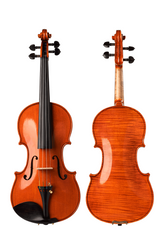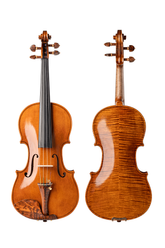How do you know how much your violin is worth?
As a beginner violinist, or you're shopping for a beginner violin, then maybe you can't tell if the violin is worth that much or worry that you're spending more. Then please take a few minutes to read this article in detail to help you avoid spending more of your budget when purchasing.
There are different levels of violin, determine your budget according to your needs
Before you can determine how much each violin is worth, you must have a clear understanding of your playing level and the budget you need to spend. There are different levels of violin, such as beginner violin, intermediate violin, advanced violin, etc. If you want to know more about the violin price system, you can read "How much does a violin cost? Take a few minutes to easily understand the violin price system" This article. Each level of violin will have a different price, so if you are a violin beginner, you only need to buy a violin at the price of a beginner violin. Generally speaking, you need 200-500 US dollars, instead of needing more budget.
What you need to know most is the value of the beginner violin, not anything else
Today's Internet is very developed, you can get a lot of methods to judge the value of a violin through Google, but what I want to tell you is that these methods may not be suitable for you. Because all you need to know is whether the beginner-level violin you want to buy is worth the money, not whether the violin is good or bad. Therefore, when judging whether a beginner violin is worth the money, it cannot be the same as the judgment standard of an antique violin. After all, you do not need to pay such expensive money. So how to judge whether the violin is worth buying? It is good to judge from the following four dimensions.
1: The craft of making the violin
Cremona in Italy is the birthplace of the modern violin. Cremona was the birthplace of many world-renowned master violin makers, such as Andrea Amati, Antonio Stradivari, and Giuseppe Guarneri. The violin-making techniques and standards handed down by these masters have become the standards of modern violins, and it is difficult to make a big breakthrough. Therefore, the technological process of the current luthiers is the same, and the difference is the luthier's luth-making ability.
For beginner violins, in order to meet the huge market demand, these violins are often not made by luthiers alone but are divided into different processes and handmade by skilled craftsmen. The advantage of this division of labor is that it can greatly improve the production efficiency of the violin, and the produced violins are all of a unified standard, which is completely made according to the size of the violin, but the disadvantage is that it cannot be made according to the characteristics of each piece of wood, and it is difficult to produce a high-quality violin, but if it is used to learn the violin, it is enough. Therefore, craftsmanship is not an important criterion when judging how much a beginner violin you want to buy is worth. As long as there are no obvious flaws in appearance and size, it can meet the criteria for judging a beginner violin.
2: The wood of the violin
The wood of the violin is a very important criterion. By distinguishing the wood of the violin, the value of the violin can be quickly judged.
Origin and drying time of wood
Although many luthiers are still experimenting with different woods to make violins, maple and spruce are recognized as very suitable woods for making violins. In addition to European woods, maple and spruce are also suitable for making violins in many areas in the northern hemisphere, such as Northeast China, Yunnan, and Sichuan. The growth of wood is greatly affected by factors such as environment, latitude, and altitude, so there will be some differences in wood in different regions. Generally speaking, European wood is more used for the production of high-end violins, while Chinese wood is mostly used for the production of medium and low-end violins. Of course, this is not to say that Chinese materials cannot make high-end violins. Violins made by Chinese master violin makers using Chinese wood can also win prizes in international violin-making competitions, just because violins made of European wood require a higher cost and has a higher chance of making a good violin. So for beginners, you need to look at the description of the violin wood by the merchant. If it is European wood, it is usually more expensive.
The wood is not ready to use and needs to be dried for a certain period. How to process specific wood, you can read the article "Basic knowledge of violin wood 2: wood processing" to understand. Generally speaking, it takes at least a few years to dry before making a violin, so if it is a beginner violin, you can judge its price by the drying year of the violin. The longer the drying time, the more valuable the wood. In addition, for Chinese violin wood, there is no drying time of more than 30 years, which is very understandable, because there was no large-scale production of violins in Chinese history before, and the use and purchase of Chinese violin wood are also in recent decades. So it is impossible to have a Chinese violin wood that has existed for hundreds of years.
Grade of violin wood
There are also grades of wood. Generally speaking, the wood of violin is divided into six grades: top, 4A, 3A, 2A, 1A, and popular. The higher the grade, the more expensive the material. According to the origin of wood, it can be divided into European material and Chinese material. Generally speaking, to judge a beginner violin, you only need to observe the wood of the back plate, because the wood of the top plate only needs to be spruce with a grain of wood per millimeter.
Top wood:
The characteristics of the top wood are obvious patterns, delicate materials, moderate hardness and softness, rich rays, and straight lines without breakage.
Example: Fiddlover Master Grade Violin 1 Piece Q031, Price: $2399.

4A grade wood:
The characteristics of 4A-grade wood are obvious patterns, moderate hardness, and softness, and the lines are straight without breaking.
Example: Fiddlover Concert Full Size 4/4 Intermediate Violin Q020, $1249.

3A grade wood:
3A grade wood is different from top and 4A grade wood. In terms of appearance, the pattern is not so obvious, and the pattern gradually becomes weaker from one end to the other.
Example: Fiddlover Beginner Violin Retro Set L016, $599.

2A grade wood:
The wood pattern of the 2A grade will be shorter than that of the 3A grade, and the pattern distribution will be uneven.
Example: Fiddlover Full Size Elegant Violin Set L014, $369.

Grade 1A wood:
Class 1A wood is wood with a very light and looming patterns.
Example: Fiddlover Advanced Violin Beginner Outfit L007, $349.

Popular wood:
Unpatterned wood.
Example: Fiddlover Student Violin Kit L005, Price: $269.

Of course, the grading of each material supplier will be inconsistent, but a preliminary judgment can be made based on the above description. The higher the material grade, the more expensive the violin. (If you find a very cheap violin with a very beautiful pattern when you buy a violin, then the pattern of this violin is usually an artistic grain rather than the grain of the wood itself)
Combination of wood
Generally speaking, the ribs and headstock of a violin are often made of the same piece of wood as the back plate, so that the overall color and pattern can be consistent. Sometimes the best maple is used for the back plate in order to save on the beautiful and expensive imported maple. Or because the pattern is too obvious, the wood grain is too deep, and it is very easy to break when making the rib, other maple wood with similar patterns will be used to make the rib and headstock.
In general, a violin with the same color and pattern on the back plate, rib, and headstock will be better and more expensive. (If the back plate is two-piece, the pattern of the two pieces of wood these is closer are better)
3: Accessories for the violin
The material of the accessories is also one of the factors that affect the price of the violin. For beginners though, this is not a very important factor, so it is good to know the different types of accessories, the price of which does not differ much in beginner violins. Just choose the accessories you like. The more common ones are ebony, snakewood, hematoxylin, boxwood, jujube, rosewood, etc.
4: Beginner outfit
At present, violin merchants in the market generally sell their beginner violins in the form of sets, such as Fiddlover's beginner violin series. This is because for many beginners, it is not clear what things are needed to start learning the violin, or it is not very convenient to obtain everything to start practicing the violin, so the form of the set is more suitable for beginners, for more professional violinists come to say, just sell violins and not violin sets. So the content of the outfit is also one of the factors that affect the price.
In addition to the violin itself, the beginner violin set will also include a case, bow, rosin, shoulder rest, spare strings, and a cleaning cloth. These are all necessary for beginners. As a violin set, it is more economical than buying each accessory separately, so it is a better choice to buy a violin set directly. Of course, you can understand the quality of the gift set before purchasing it, a good violin set can bring you a better experience.
Many factors affect the price of a violin, but for beginners, as long as you master the above four factors, you can buy your favorite violin with confidence.
Follow Fiddlover to learn more about the violin.





